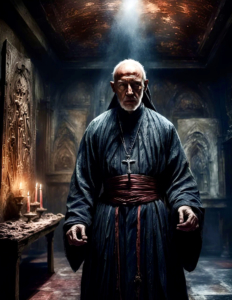We support our Publishers and Content Creators. You can view this story on their website by CLICKING HERE.
Popular culture is awash with the horror genre. Television shows, video games, movies and literature on the occult gush forth seeming to make the ironic point that the more our society becomes scientifically secular the more appetite there is for the supernatural.
It seems impossible to avoid the tsunami of paranormal investigators, zombies, vampires and their vamps or invasions of the living dead. Happily, the heroes inevitably zero in on the zombies, drive the stake through the vampire’s heart, fire the silver bullet that kills the werewolf, and wields the cross that drives the demon back to hell.
Within the horror genre the sub-genre of the exorcism film takes the phenomenon of the paranormal from the realm of fantasy to fact. While there are fictional exorcism movies, the genuine exorcism film is more chilling because it always claims to be based in real life.
William Peter Blatty’s classic 1973 The Exorcist was the first to introduce a wide audience to the reality of the demonic. Mr. Blatty’s book and film script was based on the case history of Roland Doe (not his real name) who was born around 1936 into a German, Lutheran-Christian family from Maryland, during the 1940s. Roland was was particularly close with his Aunt Harriet, a spiritualist who introduced him to a Ouija board. When Harriet died in St. Louis when Roland was thirteen, it is assumed that the boy tried to contact her via the Ouija board. The resulting possession and exorcism are well documented, and Mr. Blatty’s popular treatment opened the door to a stream of fact based exorcism films.
Director Scott Derrickson in The Exorcism of Emily Rose filters the exorcism story through a tense courtroom drama. Based on the affliction of the young German woman Anneliese Michel, The Exorcism of Emily Rose showed the difficulties and dangers of the ministry of exorcism. The possessed girl died, and the exorcists were put on trial for wrongful death. The 2011 movie The Rite, starring Anthony Hopkins, was rooted in the experiences of California Catholic priest, Fr. Gary Thomas. In The Rite the battle with Satan reflects the faith struggles of a modern American priest as he faces the ancient foe.
Deliver Us From Evil is the latest film to deal explicitly with exorcism. Set as a gritty New York crime drama, it is based on the experiences of NYPD cop, Ralph Sarchie. The exorcist is Fr. Mendoza—a young unconventional Jesuit who grapples with Satan and thereby draws Sarchie back to his faith and the young family he was neglecting.
The power and importance of exorcism movies in popular culture is that they make the spiritual struggle. Motion pictures are pictures that move so spiritual subjects are notoriously difficult to translate into cinematic form. For those who do not believe in the Christian sacraments—where the spiritual realm infuses into the physical—exorcism provides the one chilling and convincing evidence of the existence of non physical intelligent beings. As such, exorcism movies make the darkness visible.
What the exorcism films provide is a kind of iconography of evil. The Father Mendoza character in Deliver Us From Evil tells Sarchie that he has witnessed plenty of human evil, but this is “secondary” evil. Fr. Mendoza is going to introduce him to “primary” evil that is pure malevolence. In human evil there is always a mixed motive, so when we see cop Sarchie pound a pedophile murderer to death with his bare fists we understand that he does so in seemingly justified vengeful rage. Fr. Mendoza says the primary evil knows no such rationale.
An exorcist explained it to me in similar terms. “The difficulty of the ministry of liberation,” he explained “is that Satan is a liar.
He not only lies constantly, but it is as if he can do nothing but lie. He is not only the father of lies. He IS a lie. Therefore when dealing with the demonic, all is chaos. Everything slips and slides away. Were you looking for a motive or an answer? There is no motive or answer. For Satan there is no truth. There is therefore no reason. There is no mixed motive. There is simply pure evil.
In making the darkness visible, exorcism movies remind us of the great abyss, and that the relativistic denial of truth leads one into this very irrational chaos.
The second thing the exorcism movies make visible is the bestial nature of the demonic. Without truth and rational capacity the possessed persons become sub human. They transmogrify into animal like forms, howling, hissing, growling and roaring. They snarl, bite, and scratch. The lie forces human beings into a sub human bestial condition. Those who are taken over by evil become irrational brutes.
Finally, the exorcism movie makes visible the darkness of irrational rage. The demon-possessed are incarnations of pure rage. Because there is no truth there is no rationality. Because there is no rationality there is chaos and absurdity, and in the midst of that chaos and absurdity the most frighteningly irrational rage pours forth. The demonically-possessed are trembling and consumed with rage. As modern society disintegrates into chosen evil, the irrationality of relativism and increasingly bestial behavior, we should be prepared for an outpouring first of irrational rage and ultimately of violence.
Exorcism movies provide a prophetic voice crying in the wilderness. In making the darkness visible they hold up a mirror to our vulnerability and vices as individuals and as a society.
Explicit demon possession is rare, but participation and submission to secondary evil is everywhere with us. In Deliver Us From Evil, the reality of possession by secondary evil is hammered home as the cop’s sidekick jokes about his sexual immorality and has the names of the seven deadly sins tattooed on the back of his neck. He has clearly given himself to secondary evil, and so ends up being one of the demon possessed killer’s victims, while cop Sarchie rediscovers his faith and starts the journey into the light. As a morality tale and warning, the exorcism film delivers a powerful punch and a sobering reminder to be vigilant, for the enemy stalks about like a roaring lion seeking whom he may devour.
This essay was first published here in July 2014.
The Imaginative Conservative applies the principle of appreciation to the discussion of culture and politics—we approach dialogue with magnanimity rather than with mere civility. Will you help us remain a refreshing oasis in the increasingly contentious arena of modern discourse? Please consider donating now.
The featured image is courtesy of Pixabay.
Share This Story, Choose Your Platform!
Go to Top

 Conservative
Conservative  Search
Search Trending
Trending Current News
Current News 







